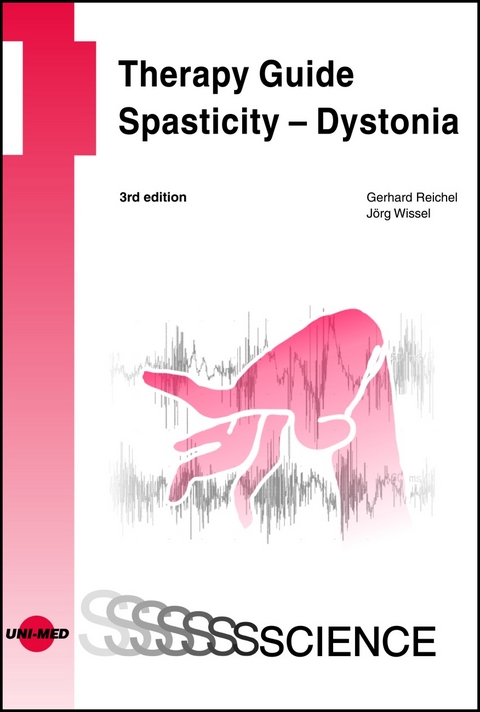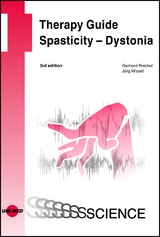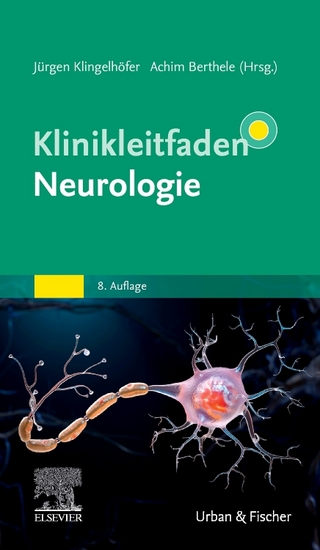Therapy Guide Spasticity - Dystonia
UNI-MED (Verlag)
978-3-8374-1556-8 (ISBN)
- Titel ist leider vergriffen;
keine Neuauflage - Artikel merken
1.Spasticity14
1.1.Introduction14
1.2.Clinical Presentation19
1.2.1.Neurological Examination19
1.2.2.Additional Methods of Examination21
1.2.2.1.Reflex Measurement and Electromyography22
1.2.2.2.Imaging Methods23
1.2.2.3.Pedography and Kinematic Measurements24
1.2.2.4.Nerve Blocks25
1.2.3.Practical Procedures25
1.2.3.1.Clinical Examination25
1.2.3.2.Specific Clinical Tests for Documentation of Spasticity26
1.2.3.3.Documentation of Everyday Competence in spasticity26
1.2.4.Evaluation Scales for Spasticity and Effects26
1.2.5.Spastic Patterns of Posture and Movement27
1.3.Treatment28
1.3.1.General Facts28
1.3.1.1.Indication and Goals28
1.3.1.2.Planning the Therapy29
1.3.1.2.1.Treatment Modifiers30
1.3.1.2.2.Treatment Principles30
1.3.2.Pharmacological Treatment32
1.3.2.1.Systemic Oral Therapy32
1.3.2.1.1.Oral Drug Treatment33
1.3.2.1.2.Further Drugs35
1.3.2.2.Local Therapy36
1.3.2.2.1.Local Anaesthesia36
1.3.2.2.2.Alcohol, Phenol37
1.3.2.2.3.Botulinum Toxin (BoNT)37
1.3.2.3.Intrathecal Baclofen Therapy (ITB)50
1.3.3.Surgery52
1.3.3.1.Surgery of the Nervous System52
1.3.3.2.Surgery of the Musculoskeletal System53
1.3.4.Ortheses and Plaster Cast55
1.3.5.Physiotherapy and Occupational Therapy57
1.3.5.1.Physiotherapy57
1.3.5.2.Occupational Therapy58
1.4.Therapy of Special Clinical Presentations58
1.4.1.Upper Extremity58
1.4.1.1.Adduction and Internal Rotation of the Shoulder58
1.4.1.2.Elbow Spasticity61
1.4.1.3.Pronation and Supination of Forearm and Hand62
1.4.1.4.Spasticity of Wrist and Finger Muscles63
1.4.2.Lower Limb69
1.4.2.1.Equinus and Varus Foot69
1.4.2.2.Valgus Foot72
1.4.2.3.Extension of the Big Toe73
1.4.2.4.Spasticity of Knee Extensors73
1.4.2.5.Spasticity of Knee Flexors74
1.4.2.6.Spastic Flexion of the Hip76
1.4.2.7.Thigh Adductor Spasticity80
1.4.2.8.Toe Flexor Spasticity81
1.4.3.Further Clinical Pictures81
1.5.Special Therapy of Spasticity caused by Cerebral Palsy (CP) in Childhood and Adolescence85
2.Dystonia92
2.1.Introduction92
2.2.Definitions93
2.3.Clinical Classification94
2.3.1.Pathophysiological and Clinical Features94
2.3.2.Classification of Dystonia98
2.4.Diagnostics101
2.4.1.Aetiologic Diagnostics101
2.4.2.Phenomenological Diagnostics102
2.5.Therapy104
2.5.1.General Facts104
2.5.2.Pharmacological Treatment of Dystonia104
2.5.2.1.Systemic Therapy104
2.5.2.1.1.Anticholinergics105
2.5.2.1.2.Benzodiazepine105
2.5.2.1.3.L-Dopa (with Decarboxylase Inhibitor)106
2.5.2.1.4.Further Medication106
2.5.2.2.Local Therapy (Botulinum Toxin)107
2.5.2.3.Intrathecal Baclofen Therapy107
2.5.3.Physiotherapy107
2.5.4.Orthesis and Surgery108
2.5.5.The Role of Psychotherapy111
2.6.Therapy of Special Clinical Presentations111
2.6.1.Generalised Dystonia111
2.6.1.1.Idiopathic Torsion Dystonia – Dystonia Musculorum Deformans111
2.6.1.2.Myoclonic Dystonia114
2.6.1.3.L-dopa-sensitive Dystonia115
2.6.1.4.Paroxysmal Dystonic Syndromes117
2.6.1.4.1.Paroxysmal Kinesiogenic Dystonia (Choreoathetosis) (PKD, [DYT10, DYT19] )118
2.6.1.4.2.Paroxysmal Non-kinesiogenic Dystonia (Choreoathetosis) (PNKD [DYT8, DYT20])118
2.6.1.4.3.Benign Infantile Paroxysmal Dyskinesia (Benign Paroxysmal Childhood Torticollis)118
2.6.1.4.4.Paroxysmal Nocturnal (Hypogenic) Dystonia (Dyskinesia, PND)118
2.6.2.Focal and Segmental Dystonia119
2.6.2.1.Blepharospasm120
2.6.2.1.1.Clinical Variations of Blepharospasms122
2.6.2.1.2.Clinical Pictures Important for Differential Diagnosis127
2.6.2.2.Dystonia of the Oropharyngeal / Laryngeal Area138
2.6.2.2.1.Oromandibular Dystonia138
2.6.2.3.Further Movement Disorders of the Oromandibular and Neighbouring Regions144
2.6.2.3.1.Spasmodic Dysphonia147
2.6.2.4.Cervical Dystonia and Dystonic Head Tremor – The COL-CAP Concept149
2.6.2.4.1.Special Diagnosis and Therapy of Cervical Dystonia in Childhood180
2.6.2.5.Arm and Hand Dystonia184
2.6.2.6.Leg and Foot Dystonia193
2.6.2.7.Dystonia of Trunk Muscles195
2.6.3.Botulinum Toxin in Tic Disorders196
2.6.4.Drug-induced Dystonia197
2.7.Dystonia and Trauma198
3.Vegetative Symptoms and Pain204
3.1.Introduction204
3.2.Urological Indications204
3.2.1.Neurogenic Detrusor Overactivity204
3.2.2.Idiopathic Detrusor Hyperactivity205
3.2.3.Interstitial Cystitis205
3.2.4.Detrusor Sphincter Dyssynergia205
3.2.5.Benign Prostatic Hyperplasia205
3.2.6.Other Urological Indications206
3.3.Gastroenterological and Gynaecological Indications206
3.3.1.Achalasia206
3.3.2.Diabetic Gastroparesis and Pyloric Stenosis208
3.3.3.Sphinkter of Oddi Dysfunction209
3.3.4.Anal Fissure209
3.3.5.Other Proctological Indications210
3.3.6.Obstructed Defaecation Syndrome (ODS)210
3.4.Genital Indications211
3.4.1.Pelvic Floor Dyssynergia: Vaginismus211
3.4.2.Vulvodynia212
3.4.3.Ejaculatio Praecox212
3.4.4.Prophylaxis of Recurring Low-Flow Priapism212
3.5.Pain214
3.5.1.Chronic Migraine214
3.5.2.Other Headaches215
3.5.3.Nerve Compression Syndromes216
3.5.3.1.Pronator Teres Syndrome216
3.5.3.2.Posterior Interosseous Nerve Syndrome217
3.5.3.3.Piriformis Syndrome218
3.5.3.4.Neurogenic Thoracic Outlet Syndrome222
3.5.4.Epicondylitis Radialis Humeri (Tennis Elbow) and Epicondylitis Ulnaris Humeri (Golfer’s Elbow)224
3.5.5.Chronic Plantar Fasciitis (Heel Spur)224
3.5.6.Morton Neuralgia225
3.6.Glands226
3.6.1.Axillary Hyperhidrosis226
3.6.1.1.Frey's Syndrome227
3.6.2.Other Hyperhidroses227
3.6.3.Sialorrhea228
3.6.4.Hyperlacrimation (Crocodile Tears)230
3.6.5.Rhinorrhea231
3.7.Diaphragmatic Myoclonus, Singultus231
3.Appendix235
3.1.Neuroanatomy of Muscles in Spasticity of the Extremities – Guidance for Botulinum
Toxin Therapy235
3.2.Neuroanatomy of Neck Muscles in Cervical Dystonia251
4.Further Literature260
Index268
| Erscheinungsdatum | 10.09.2021 |
|---|---|
| Reihe/Serie | UNI-MED Science |
| Verlagsort | Bremen |
| Sprache | englisch |
| Maße | 178 x 245 mm |
| Gewicht | 644 g |
| Themenwelt | Medizin / Pharmazie ► Medizinische Fachgebiete ► Neurologie |
| Schlagworte | botulinum toxin • Dystonia • spasticity |
| ISBN-10 | 3-8374-1556-2 / 3837415562 |
| ISBN-13 | 978-3-8374-1556-8 / 9783837415568 |
| Zustand | Neuware |
| Haben Sie eine Frage zum Produkt? |
aus dem Bereich




